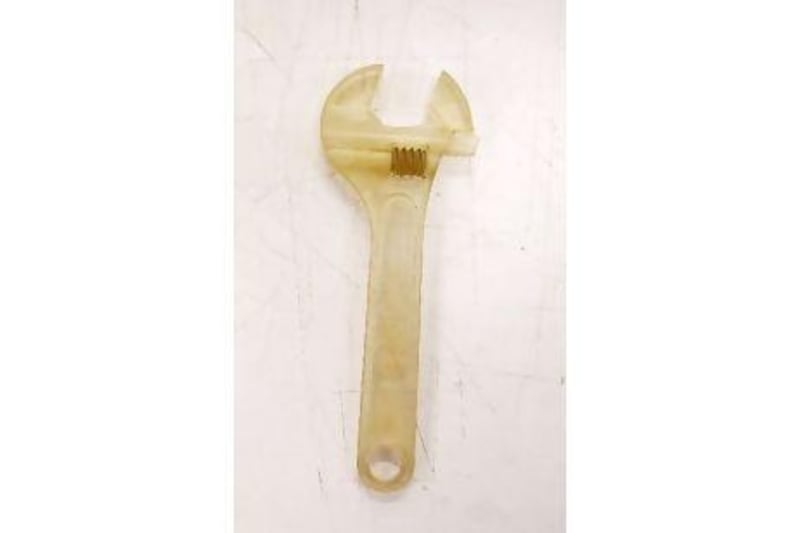A new mobile phone has been released, packed with all the latest bells and whistles. You can't wait to get hold of one. You check out the price on a couple of websites and click "buy". So far, so familiar. But what happens next is not.
Instead of waiting for a call from Aramex to say your purchase is ready for delivery, you are emailed a digital file.
A machine chugs to life, and before your very eyes the phone takes shape. The machine in question is a 3D printer, a device that creates solid three-dimensional objects from digital files.
According to Michael Dosier of the American University of Sharjah (AUS), which is pioneering the use of the machines in the UAE, they are set to revolutionise manufacturing, retail, distribution and employment.
His view is shared by The Economist magazine, which reported that "three-dimensional printing ... may have as profound an impact on the world as the coming of the factory did".
They cannot make a mobile phone just yet, but new uses are coming thick and fast. A team from Cornell University in the United States has produced edible food, while others have made car bodies and furniture.
"The end game is a machine like this in every house that can print anything you want," said Mr Dosier, the lab director at AUS's College of Architecture, Art and Design. "The whole notion of industry changes if we don't have big manufacturing facilities any more but we have these micro-distributive facilities.
"It's a very different mode of operating. Think about supply chains. If you follow the production line for a Coke can, you watch materials flying back and forth all around the planet before you get to an actual Coke can. The amount of energy and material and fuel wasted to just deliver that Dh2 can of Coke is tremendous.
"If all that gets eliminated because all we're delivering now are some materials to a machine and we're piping some data over a network cable that has to be there regardless, all of a sudden these supply chains become a very different animal."
The widespread use of the technology could greatly reduce the number of factory jobs, and 3D printing also opens up the possibility of customising products to meet a buyer's exact needs.
"I could buy someone's design for a 3D printed mobile phone or tap into an open-source platform that lets me adapt the phone to my needs," said Mr Dosier. "So maybe my screen is bigger than your screen - I make that choice. It can exactly fit my pocket, or your camera can fit your hand exactly and no one else's."
The potential goes far beyond industry. Researchers have demonstrated how the technology could be used to create kidneys and other human organs for transplantation.
Earlier this year, a team in Belgium announced it had replaced an 83-year-old woman's badly infected lower jaw with a printed replacement. Others have taken CT scans of King Tutankhamun's mummy and created an exact replica.
AUS has three machines - one that builds up objects using powder and two that use plastics. They use special software to convert 3D images into a digital pattern made up of many thin horizontal layers. The powder or plastic is deposited layer by layer, building up to form the final object.
In the powder machine, print heads - like the ones in everyday inkjet printers - deposit a glue in the desired pattern. The glue bonds grains of powder into the desired shape, and the base on which the object is produced descends gradually as each layer of glued powder is added.
When complete, the object lies within a cube of powder and has to be dug out. The surplus can then be recycled for future use.
The college is opening up the use of its machines to students and staff across the university, but eventually hopes to let others use it, too.
"We're here first for the college students and to support their endeavours and faculty research," said Mr Dosier.
"But beyond them we recognise our role as a community asset. We're trying to figure out what our role is in engaging with the community and to what degree we open up."
Sarah Alagroobi, 22, an Emirati student from Sharjah, used the powder machine to create a prototype chair that was exhibited in April at a design fair in Italy.
She remembers the excitement of seeing her chair emerge from the white dust.
"It was an experience almost like a discovery," she said. "I had no idea what was going to come out of the printer.
"My piece has a ridiculous degree of complex geometry and I never knew that the resolution [of] the 3D printer was going to be to that degree. It was perfect. It was almost like I was looking at it on the computer. It's very rare as a designer to have something in your software that is outputted in the same way.
"Having facilities to work on a three-dimensional scale does not only aid us in making something but encourages us to think beyond what we think we're capable of doing.
"The fact that they are open to us for our enjoyment and pleasure is just great."






